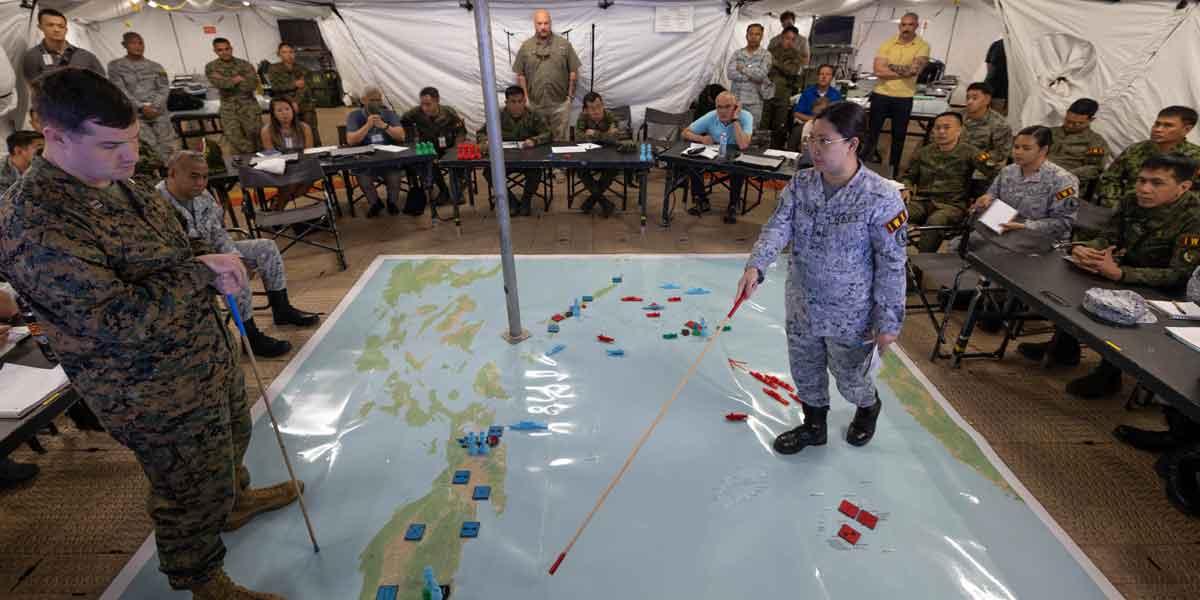By Richard Javad Heydarian
Indonesia, the Association of Southeast Asian Nations’ current revolving chair (ASEAN), is set to stage the first-ever joint military drills among just Southeast Asian bloc’s navies, crucially at a time of escalating US-China tensions.
According to Indonesian military chief Yudo Margono, the drills will be held in “the North Natuna Sea,” a resource-rich area off the coast of Indonesia’s Natuna islands.
Jakarta expressly renamed the area as the “North Natuna Sea”, similar to the Philippines’ designation of its exclusive economic zone (EEZ) in the South China Sea as the “West Philippine Sea”, in order to challenge Beijing’s claims of “traditional rights” in the waters. The islands have been a long-time site of illegal Chinese fishing more recently fortified by a Chinese Coast Guard ship presence.
Back in 2020, Indonesian armed forces deployed at least six warships and four jet fighters to the area in order to protect the country’s claimed sovereign rights.
During a rare high-profile visit to the Natuna Islands, Indonesian President Joko Widodo took an uncompromising position by categorically rejecting any Chinese claims in the resource-rich waters, which overlap with the tip of Beijing’s expansive “nine-dash line” claims in the South China Sea.
Indonesian military spokesperson Julius Widjojono made it clear that the planned ASEAN joint exercises are in response to the “high risk of disaster in Asia, especially Southeast Asia.”
In recent months, Manila has accused China’s coast guard of engaging in “aggressive tactics” and “dangerous maneuvers” in Philippine waters, just as Chinese armed forces challenged American reconnaissance activities in the South China Sea and the Taiwan Strait.
As the regional body’s chairman this year, Jakarta seems intent on reversing the growing marginalization of ASEAN in shaping crises in its own backyard.
Enmeshing superpowers
To be clear, ASEAN nations are no strangers to joint military drills. Over the past decade, Southeast Asian nations have conducted such activities with all major powers.
Back in 2019, for instance, ASEAN navies conducted a five-day-long ASEAN-US Maritime Exercise (AUMX), which began at Thailand’s Sattahip naval base in Chonburi province in the Gulf of Thailand and extended all the way to Cape Cà Mau in southern Vietnam in the South China Sea.
Pre-drills, meanwhile, were held in Brunei and Singapore, underscoring the depth and sophistication of the joint exercises. As many as 1,260 personnel, eight warships, and four aircraft took part in AUMX, with Indonesia and Malaysia serving as observers.
Back then, the Pentagon deployed the USS Wayne E Meyer guided-missile destroyer, USS Montgomery littoral combat ship, P-8 Poseidon aircraft and multiple MH-60 helicopters for the joint drills with ASEAN nations.
Meanwhile, Southeast Asian nations also deployed their own main warships, namely the RSS Tenacious frigate (Singapore), the HTMS Krabi (Thailand), KDB Ramon Alcaraz (Philippines), the KDB Darulaman offshore patrol vessel (Brunei) and UMS Kyan Sittha frigate (Myanmar).
By that time, ASEAN nations had already conducted three naval drills with China. The most high-profile was the inaugural ASEAN-China Maritime Exercise drills in the southern Chinese city of Zhanjiang a year earlier in 2018.
Vice Admiral Shen Jinlong, commander of the (PLA) Navy, characterized the exercises as the country’s vision of “building a maritime community with a shared future” with ASEAN nations.
Meanwhile, ASEAN states also participated in Joint Maritime Drill in Qingdao, China to commemorate the People’s Liberation Army’s (PLA) 70th founding anniversary. China also conducted naval drills in Singapore’s waters in the same year.
But regional maritime tensions have only escalated over the succeeding years. In late 2019, a number of key ASEAN states began to toughen their stance against China in contested waters.
First came an unprecedented warning by Vietnamese deputy foreign minister Le Hoai Trung, who openly threatened potential “arbitration and litigation measures” against China amid festering disputes in the South China Sea.
A month later, Malaysia took observers by surprise when it submitted a claim for an extended continental shelf to the United Nations, directly challenging China’s (and Vietnam’s) expansive claims in the southern portions of the South China Sea basin.
In response to China’s criticisms, then-Malaysian foreign minister Saifuddin Abdullah dismissed Beijing’s claims as “ridiculous” and went so far as to threaten international arbitration to assert his country’s claim, similar to the Philippines successful move at an arbitral tribunal at The Hague in 2016.
Within weeks of Malaysia’s moves, Indonesia found itself at loggerheads with China over the Natuna Islands.
Amid a growing Chinese paramilitary presence in the North Natuna Sea area, the Indonesian Foreign Ministry openly accused China of a “violation of [its] sovereignty” and directly rejected the latter’s claim to “traditional fishing rights” in the area as having “no legal basis” in modern international law including UNCLOS.
It didn’t take long before Indonesian President Widodo, earlier accused of being too soft on China, made a historic visit to the Natuna area, where he declared: “We have a district here, a regent, and a governor here. There are no more debates. De facto, de jure, Natuna is Indonesia.”
The Indonesian military also bolstered its position in the Natuna area to counter any potential contingencies.
Rising Resistance
Although more assertive on an individual basis, ASEAN nations failed to present a collective response. In fairness, Indonesia repeatedly tried to steer regional states towards greater unity on the maritime disputes.
In 2015, the de facto ASEAN leader proposed joint patrols to send a clear message that no single nation should “build up strength or threaten anyone” in the area.
Eager to maintain stable ties with Beijing back then, however, Indonesia didn’t rule out joint patrols with China. But two years later, during the inaugural Australia-ASEAN Summit in Sydney, Widodo proposed a variation on the same theme, except this time he called for joint patrols by non-claimant regional states excluding China.
In 2021, the Indonesian Maritime Security Agency, known as Bakamla, proposed an ASEAN Coast Guard forum as a “great opportunity for ASEAN coast guards and maritime law enforcement agencies to talk and cooperate with each other.”
Earlier this year, Widodo once again emphasized the need for “ASEAN unity” in order to address regional crises. Philippine President Ferdinand Marcos Jr highlighted rising maritime tensions and underscored the “necessity to resolve all sovereignty and jurisdictional issues pertaining to the South China Sea by peaceful means without resort to force.”
In response, ASEAN leaders welcomed “develop[ing] guidelines for accelerating the early conclusion of an effective and substantive” Code of Conduct (COC) in the South China Sea during the summit in Indonesia last month.
The Indonesian-led ASEAN drills later this year are thus seen as part of ongoing efforts to arrest escalating tensions in the region as well as reinforce the regional body’s “centrality” in shaping its own backyard.
“We will hold joint military drills in the North Natuna Sea,” Indonesian military chief Yudo Margono said after a meeting of Southeast Asian defense chiefs in Bali this month.
The top Indonesian general made it clear that the ASEAN naval drills, scheduled for September, won’t include combat operations but emphasized the need for strengthening “ASEAN centrality.”
Follow Richard Javad Heydarian on Twitter at @Richeydarian






















